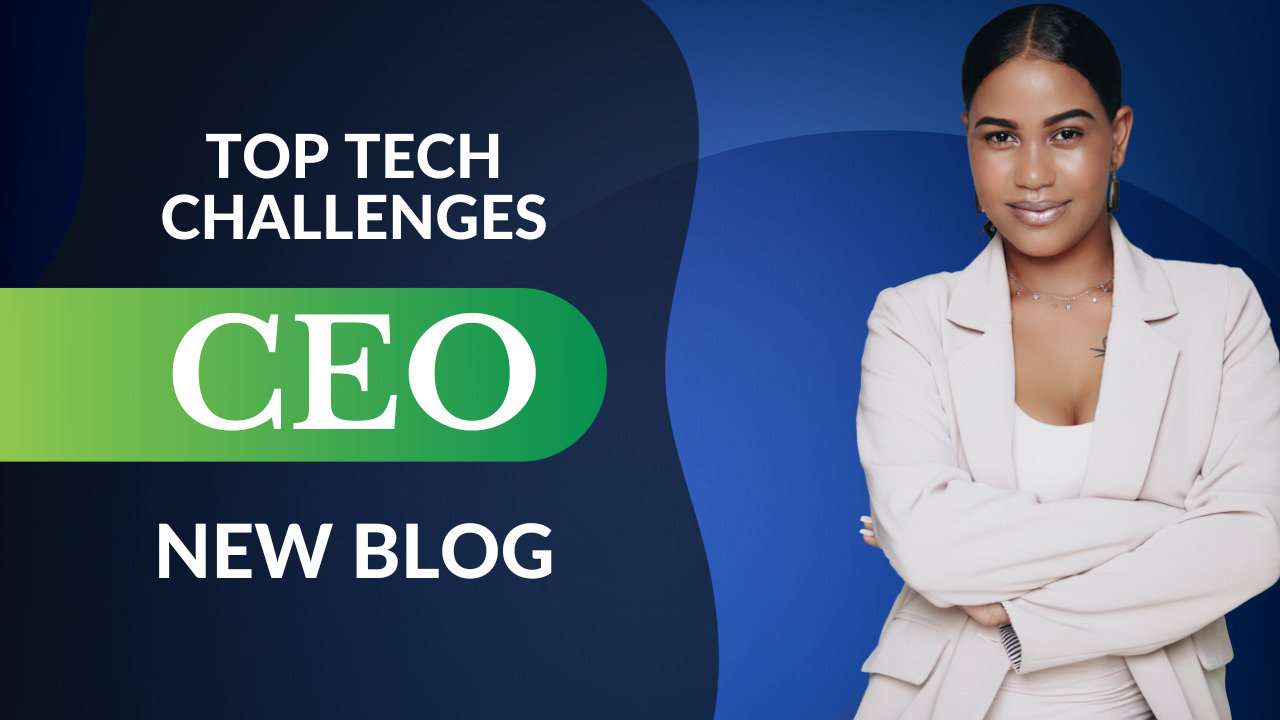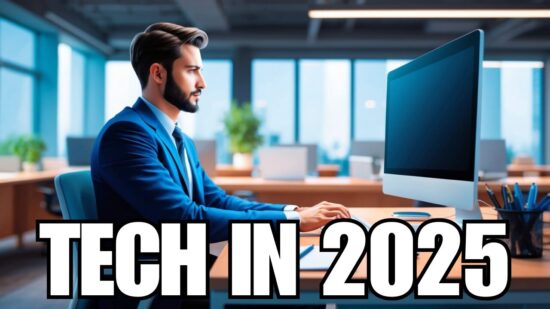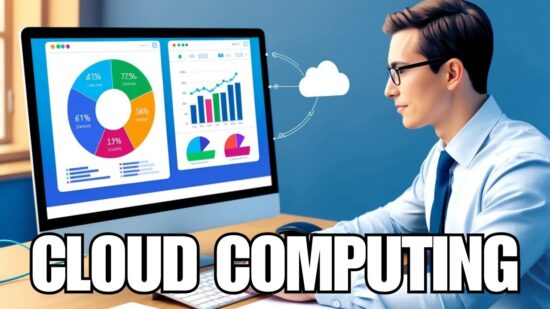Top Technology Challenges Facing Corporate CEOs In 2024: Navigating Innovation and Security Risks
As we anticipate the landscape of 2024, corporate CEOs are presented with an array of technology challenges that could impact the trajectory of their organizations. With rapid advancements in artificial intelligence and automation reshaping industries, leaders must strategically integrate these technologies to stay ahead. They face the need to balance the adoption of innovative tools with the management of a workforce evolving in step with these changes, ensuring that they harness the power of AI without displacing the human element crucial to their operations.
In parallel, the digital sphere is becoming increasingly fraught with cybersecurity threats that demand a robust and proactive response. CEOs must invest in cutting-edge solutions to protect their company’s data and customers’ privacy. The perpetual challenge of remaining competitive is intensified by the growing importance of data-driven decision-making and the pressing need to undergo digital transformations that align with current and future market demands.
Navigating this complex environment requires a clear vision and the ability to confidently steer organizations through uncharted territories. Chief executives must become the architects of change, fostering a culture of innovation while managing the risks of a digitally interconnected world.
Key Takeaways
- CEOs must adapt to disruptive technologies while fostering a skilled workforce.
- Cybersecurity investments and data privacy are paramount in safeguarding company interests.
- Strategic digital transformation and innovation are critical to maintaining competitiveness.
Adapting to Artificial Intelligence and Automation
We’re witnessing a pivotal moment as organizations recognize the imperative of integrating Artificial Intelligence (AI) and automation into business operations. Our focus must be on strategic orchestration and managing the human impact of these technological advances.
Strategic Implementation of AI
Firstly, AI is not a plug-and-play solution; it demands a strategic approach tailored to each organization’s unique context. We need to prioritize key areas where AI can drive the most value and consider intelligent automation as a critical step for not only cost reduction but also for enhancing quality and speed of service delivery. Let’s break this down:
- Areas of Implementation:
- Customer Service (chatbots, personalized recommendations)
- Operations (predictive maintenance, supply chain optimization)
- Priority Aspects:
- Data security: implementing robust security measures to protect sensitive data
- Ethical considerations: ensuring AI systems operate fairly and without bias
Managing Workforce Transition
The adoption of AI and automation also means rethinking our workforce structure. We aim to balance technological integration with workforce empowerment, pivoting towards roles that AI cannot fulfill. We focus on:
- Upskilling:
- Training employees in AI-related skills
- Encouraging digital literacy
- Role Redefinition:
- Identifying new opportunities for human skills enhancement
- Creating roles that leverage human creativity and strategic thinking
We aim to maintain and enhance our organizational agility and employee engagement by guiding our teams through this transition. Together, we are setting the stage for a future that harnesses the full potential of AI and automation.

Cybersecurity Threats and Solutions
In 2024, we face a cybersecurity landscape that’s more complex and dangerous than ever before. Corporate CEOs must understand the risks and implement effective strategies to mitigate them.
Evolving Cyber Threat Landscape
The cyber threat landscape is rapidly changing, with attackers leveraging advanced technologies such as artificial intelligence (AI) and machine learning to carry out sophisticated attacks. We’re seeing a rise in ransomware targeting critical infrastructure and an increase in social engineering attacks that manipulate employees into compromising security.
One significant challenge is expanding the Internet of Things (IoT), vastly increasing the number of connected devices and potential entry points for attackers. According to a prediction from Gartner, by 2025, 60% of organizations will use cybersecurity risk as a primary determinant in conducting third-party transactions and business engagements.
Building Robust Cyber Defense Mechanisms
To combat these evolving threats, corporations must build robust cyber defense mechanisms. This can be achieved through a multi-layered security approach that includes the following:
- Employee Training: Regular training programs to educate staff on recognizing and responding to cybersecurity threats.
- Advanced Threat Detection Systems: Investment in systems that promptly detect anomalies and potential threats.
- Improved Security Protocols: Encryption, two-factor authentication, and regular security audits.
Furthermore, Marcum Technology suggests that companies adopt a proactive approach and partner with cybersecurity experts to develop comprehensive solutions. This partnership enables companies to stay agile and effectively counteract cyber risks.
We must continuously update our knowledge and tools to keep pace with these threats. In doing so, we secure our corporate assets and protect our stakeholders from potential harm.
Remaining Competitive in a Data-Driven World
In the swiftly evolving landscape we’re navigating, harnessing the power of data is no longer optional. It’s critical to stay ahead and understand the synergy between big data and analytic capabilities and the importance of maintaining data privacy and adherence to regulatory standards.
Leveraging Big Data and Analytics
Big data and analytics are pivotal in shaping our strategic decisions. We integrate advanced analytics to unearth insights leading to better customer experiences and operational efficiency. Our approach involves:
- Identifying Patterns and Trends: Using analytics to anticipate market changes and customer preferences, positioning ourselves ahead of the curve.
- Predictive Analysis: Implementing predictive models that help us assess risk and devise more informed strategies.
By adopting these methods, we ensure our decisions are guided by data-driven insights, which are foundational for robust competitiveness.
Ensuring Data Privacy and Compliance
With increasing regulatory oversight, we prioritize data privacy and compliance as cornerstones of our business practices. Our commitment involves:
- Adherence to Regulations: Rigorously following global standards such as GDPR and CCPA, ensuring our data usage is transparent and secure.
- Regular Audits: Conducting frequent reviews of our data handling practices to maintain the highest levels of compliance and integrity.
Our vigilance in data stewardship reinforces trust with our stakeholders and provides a competitive advantage, ensuring we are compliant and a leader in ethical data practices.
The Challenge of Digital Transformation
In 2024, corporate CEOs are tasked with seamlessly integrating digital technologies into their business models while overcoming organizational resistance often accompanying such sweeping changes.
Integrating Digital Technologies
Integrating digital technologies into existing business processes is essential for a competitive edge, yet it remains a complex endeavor. We recognize that this goes beyond merely adopting tools; it requires a holistic approach to digital transformation that harmonizes with our strategic objectives. The process involves various facets, from full platform observability for better decision-making to recalibrating our customer engagement strategies to leverage data analytics effectively.
- Customer Relationship Management (CRM): Our focus on CRM systems aids in better understanding and predicting customer behaviors.
- Enterprise Resource Planning (ERP): We prioritize ERP integration for streamlined operations across various departments.
Overcoming Organizational Resistance
Resistance from within is one of the most significant barriers to digital transformation. Changing long-standing processes and mindsets is not trivial, but we are committed to leading this shift. Our action plan includes clear communication of the benefits and the provision of training to ease the transition for our staff.
- Training and Upskilling: Implemented targeted training programs to enhance employees’ digital skills.
- Transparent Communication: Fostering an environment where transparent communication about these changes is standard practice.
Our approach to tackling these challenges is methodical, always pairing technological adoption with a strategic vision and an empathetic understanding of our workforce’s journey through change.
Incorporating Sustainable Practices
In the quest for sustainability, we, as CEOs, must view environmental responsibility as an integral part of our strategic planning. It’s about creating value while fostering longevity and resilience in our operations.
Developing a Sustainability Strategy
Strategic Vision & Long-term Goals: We must define what sustainability means for our organizations and establish concrete long-term objectives. Unlocking the potential to increase operational resilience and financial performance through sustainability is critical.
- Assessment of Current Impact: Assessing our current environmental footprint across all operations.
- Resource Management: Identifying opportunities to reduce energy and water usage.
- Investment in Green Technology: Allocating resources to implement technologies that reduce emissions and waste.
Meeting Regulatory and Public Expectations
Staying Ahead of Regulation: We expect more stringent requirements from governing bodies in 2024. Staying informed and proactive in compliance is imperative to safeguard our companies’ reputations and operations.
- Public Disclosure: Maintaining transparency in our practices and progress towards sustainability goals.
- Engaging Stakeholders: Ensuring internal and external stakeholders are aligned with our sustainability vision through regular communication and collaborative efforts.
Navigating Economic Uncertainty
In 2024, as corporate CEOs, we are prioritizing economic resilience. We focus on navigating unpredictable market conditions by employing prudent financial risk management and developing robust long-term investment strategies.
Financial Risk Management
We understand the importance of minimizing exposure to financial uncertainties. Our approach includes implementing advanced analytics for better forecasting and embracing diversification to spread risk. Specifically, we are enhancing our predictive models to anticipate market volatility and respond proactively. Additionally, we prioritize liquidity to ensure smooth operational capabilities in times of crisis.
Long-Term Investment Strategies
Long-term planning is key to withstand economic shifts. We are concentrating on investments in sectors with sustainable growth potential, such as renewable energy and technology. Furthermore, we balance immediate ROI and future prospects to stabilize our financial position and support continuous innovation.
Our strategic vision combines stringent financial risk management while fostering investments that promise enduring returns, ensuring that we remain adaptable and resilient irrespective of economic headwinds.
Cultivating Innovation and Entrepreneurship
In the rapidly evolving business landscape, we recognize that driving growth hinges on our ability to embed innovation and entrepreneurship into the corporate ethos. Our strategies are defined by deliberate actions that bolster creativity and harness the opportunities our competitive markets present.
Fostering a Culture of Innovation
We understand that a culture of innovation is foundational to sustaining competitive advantage. To this end, we prioritize empowering our employees. We encourage them to take calculated risks and reward their innovative efforts, understanding that failure is often a stepping stone to success. We’ve seen that facilitating regular ideation sessions and providing platforms for cross-departmental collaboration spark new ideas and fuel our entrepreneurial spirit.
- Empowerment: Each team member is encouraged to bring forward ideas with a clear pathway to elevate them.
- Collaboration: Cross-functional teams work together to pool skills and perspectives.
- Reward & Recognition: Innovative attempts are celebrated, both successful and those that provide learning opportunities.
Investing in Research and Development
Our commitment to innovation is concretized through our strategic investments in research and development (R&D). The metrics are clear—organizations that allocate substantial resources to R&D tend to stay ahead. We focus on the dual strategy of enhancing our current offerings and exploring new technological frontiers. By staying abreast of the latest technology challenges, like cybersecurity and AI, and dedicating funds to R&D, we are not only prepared for the future but actively shaping it.
- R&D Spending: Much of our budget is dedicated to R&D activities.
- Technological Advancements: We invest in advanced technologies that have the potential to disrupt markets and create new opportunities.
Leadership in a Remote and Hybrid Work Environment
Corporate CEOs face unique leadership challenges with the shift towards remote and hybrid models. Addressing these effectively is critical for our organizations to thrive in 2024.
Remote Workforce Management
To ensure success in managing a remote workforce, we must leverage technology that facilitates seamless communication and performance tracking. A specific challenge we encounter is fostering a sense of accountability and engagement among remote employees. This often involves implementing digital tools to offer real-time project updates and foster collaborative work environments, such as advanced project management software.
Additionally, we need to be cognizant of the personal well-being of our team members. Encouraging regular check-ins and making mental health resources available can effectively manage the work-life balance challenges that remote workers often experience.
Maintaining Company Culture
When it comes to maintaining company culture in a hybrid environment, our leadership is tasked with infusing our company’s values and practices into the digital workspace. Company culture must be more than just an idea; it has to be present in every video call, virtual meet-up, and digital correspondence.
One approach is to hold regular virtual team-building activities that replicate the camaraderie and engagement of in-person interactions. Another is to champion a culture of open communication, establishing clear channels where feedback is encouraged and valued. This ensures that our organizational culture remains strong and integrated into our daily operations despite the physical distance.
Managing Consumer Privacy and Trust
In anticipation of 2024, we recognize that bolstering data privacy and nurturing consumer trust is pivotal to corporate success. These two facets interlink to form the bedrock of customer relations in the digital age.
Enhancing Customer Data Protection
We must embrace robust strategies to safeguard customer data, aligning with Gartner’s projection that by 2024, 75% of the global population will be covered under privacy regulations. Adopting transparent data handling processes and investing in secure technologies will be non-negotiable for us.
- Audit Existing Data Security Measures: Reviewing and updating encryption protocols, access controls, and incident response strategies is crucial.
- Comply with International Standards: Global privacy regulations require compliance; prepare for frameworks like GDPR, CCPA, and upcoming legislations.
Building Consumer Trust
For us, building consumer trust goes hand-in-hand with transparent practices. As detailed by the Harvard Business Review, understanding how to communicate the use of customer data is essential for cultivating trust.
- Clear Communication: We will clarify how and why data is collected, used, and shared.
- Consistent User Controls: Empowering customers with control over their data strengthens trust and loyalty.
Our roadmap places privacy and transparency at the core of our operations, ensuring customer trust is at the forefront of our technological initiatives.
Addressing the Skills Gap
The technology landscape in 2024 presents a significant skills gap, which we must bridge through effective talent strategies and prioritizing learning and development across our organizations.
Talent Acquisition and Retention
To combat the skills gap, our focus on talent acquisition involves identifying candidates who are skilled, adaptable, and capable of growing with emerging technologies. We implement targeted recruitment campaigns and offer competitive benefits to attract top talent in a tight job market.
Retention is equally critical; we foster an environment that prioritizes career development, recognizes achievements, and supports work-life balance. Mentorship programs and clear career pathways are foundational to keeping our employees engaged and committed.
Employee Upskilling and Reskilling
Upskilling involves training our workforce in new, necessary technologies that align with industry trends—fortifying their current roles.
Reskilling, however, is about preparing our employees for entirely new positions. Here’s what we implement:
- Online Learning Platforms: Customized learning pathways for each employee
- Workshops and Seminars: Regular in-house training sessions led by industry experts
- Cross-Training Initiatives: Encouraging cross-departmental skill development
By equipping our staff with updated skills and knowledge, we aim to drive innovation and maintain a competitive edge in the market.
Regulatory Compliance and Government Policies
In 2024, corporate CEOs must prioritize staying ahead of regulatory shifts and cultivating strong relationships with policymakers. These elements are crucial for navigating the complex compliance landscape and ensuring corporate strategies align with legal expectations.
Adapting to Changing Regulations
With the regulatory environment constantly evolving, we must be vigilant in monitoring and adapting to these changes. Sector-specific reforms demand our attention, particularly in areas like cybersecurity, data privacy, and AI governance. For instance, the recent focus on data, models, and “model-like” risks underscores the need for robust risk management systems. We need to incorporate these regulatory updates swiftly and efficiently into our operational frameworks to maintain our competitive edge and comply with the law.
Engaging with Policy Makers
Engaging with policymakers is not just about compliance—it’s also about shaping future regulations. Our dialogues need to emphasize the impact of regulations on our businesses while considering consumers’ and broader societal interests. Staying connected through forums, coalitions, and direct dialogue is essential to provide industry perspectives on potential legislative actions. These proactive interactions can help mitigate risks from sudden regulatory changes and ensure we have a say in the legislative process.
Innovation in Product Development and Service Delivery
In corporate leadership, product innovation and service delivery are imperative for maintaining a competitive edge.
Agile Product Development
We understand that agile product development is essential for keeping pace with rapid technological changes. Our frameworks are adaptable, promoting rapid iteration and continuous feedback. By integrating the principles of Platform Engineering and AI-augmented development, we enable our teams to deliver high-quality products more efficiently.
Enhancing Customer Experience
We prioritize enhancing customer experience by leveraging customer-facing and self-service practices. Our commitment is to the seamless integration of technology in ways that advance the customer journey. Strategic investments across various customer touchpoints ensure service delivery meets and anticipates customer needs.
Global Supply Chain Vulnerabilities
In 2024, CEOs must confront the reality of increasingly complex supply chain challenges, from heightened geopolitical tensions to the persistent specter of climate change. A focus on rigorous risk assessment and developing resilient networks is critical.
Supply Chain Risk Assessment
We must first acknowledge that understanding the supply chain’s intricacies directly informs our risk management capabilities. We can gain better visibility and traceability using advanced analytics and artificial intelligence. It’s essential to adopt a proactive stance, identifying potential threats and their triggers with an eye on various factors, including market volatility, regulatory changes, and technological disruptions.
Developing Resilient Supply Networks
Building a resilient supply network in 2024 involves more than just-in-time logistics; it requires a comprehensive strategy that includes diversification of suppliers and investment in redundancy. We must pivot towards agility, enabling us to swiftly respond to unforeseen disruptions. Likewise, our commitment to sustainability can foster resilience, encouraging a move towards circular supply chain models.






